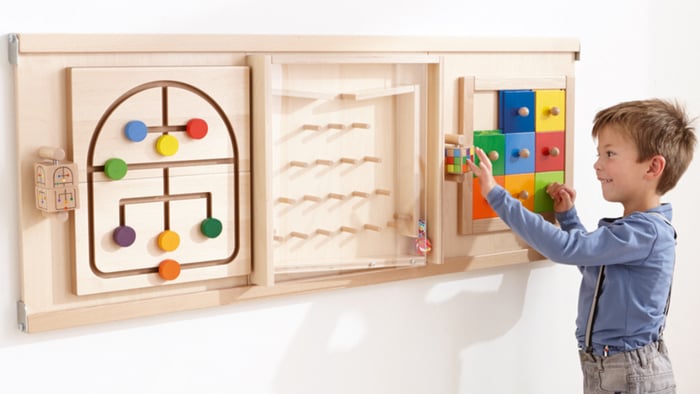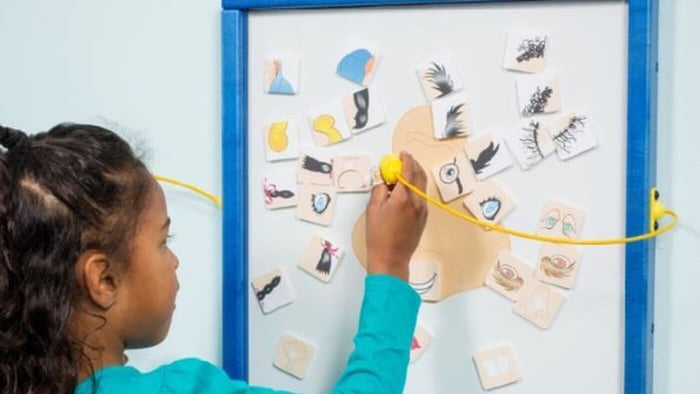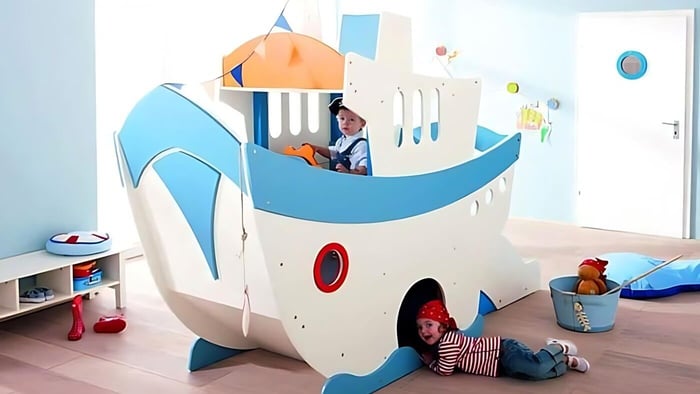
New vs Refurbished Indoor Playground Equipment: Which Pays Off?
Table of Contents
- Looking to invest in indoor playground equipment? New options offer better safety and warranties despite higher upfront costs, while refurbished equipment can save 50% initially. Consider long-term costs—maintenance and lifespan often make new equipment more economical over time.
- Key Takeaways
- Safety vs. Savings: The Real Cost Comparison
- New Equipment Advantages
- Refurbished Equipment Realities
- When to Replace vs. Repair
- Smart Investment Decision Framework
- Making the Right Choice for Your Business ROI
Looking to invest in indoor playground equipment? New options offer better safety and warranties despite higher upfront costs, while refurbished equipment can save 50% initially. Consider long-term costs—maintenance and lifespan often make new equipment more economical over time.
Key Takeaways
- New indoor playground equipment offers better safety compliance and warranties but costs significantly more upfront
- Refurbished equipment can save up to 50% on initial costs while still providing functional play structures
- The total cost of ownership often favors new equipment when factoring in maintenance, repairs, and lifespan
- Little People's Cove provides guidance on selecting play equipment that maximizes both safety and investment return
- Equipment with safety hazards like broken components or recalled parts should always be replaced regardless of age
Flora Mini Play Loft
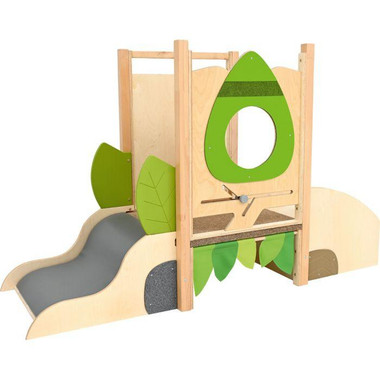
$2689.85
This mini playcenter, the Flora Mini Play Loft, is constructed from varnished plywood (3/4" thick), laminated board, and wood. It features anti-slip stairs, a slide,...… read more
Safety vs. Savings: The Real Cost Comparison
Choosing between new and refurbished indoor playground equipment often comes down to balancing immediate budget constraints against long-term operational costs. The decision impacts not just your finances but also children's safety, your business reputation, and potential liability exposure. Little People's Cove understands this challenge and works with businesses to find the optimal solution for their unique needs and circumstances.
The price gap between new and refurbished equipment can be substantial - often 30-50% less for pre-owned options. But focusing solely on the initial purchase price can lead to costly mistakes down the road. To make a truly informed decision, you need to evaluate multiple factors beyond just the sticker price.
New Equipment Advantages
1. Current Safety Standards & Reduced Liability
New indoor play equipment is designed and manufactured to meet or exceed the latest safety regulations and industry standards. This compliance isn't just a feature—it's essential protection against potential liability issues. Modern equipment incorporates safety innovations that simply didn't exist in older models, such as improved impact absorption, elimination of entrapment hazards, and more secure fastening systems.
The liability protection that comes with certified new equipment can't be overstated. Should an accident occur, having documentation that your equipment meets all current safety standards provides crucial legal protection. This documentation isn't typically available with refurbished equipment, creating a significant risk exposure.
2. Comprehensive Warranty Protection
One of the most valuable benefits of purchasing new play equipment is the warranty coverage. Most reputable manufacturers offer comprehensive warranties that protect your investment for years—often 5-10 years for structural components and 1-3 years for moving parts and smaller components.
These warranties provide peace of mind and predictable maintenance costs. When equipment fails under warranty, the manufacturer covers repair or replacement costs, protecting your budget from unexpected expenses. By contrast, refurbished equipment typically comes with limited warranties (often just 30-90 days) or none at all, leaving you financially responsible for any issues that arise.
3. Modern Designs That Attract More Customers
The visual appeal and play value of your equipment directly impacts customer attraction and retention. New equipment features the latest designs, bright colors, innovative play elements, and themes that capture children's imagination. These modern features can become a significant competitive advantage in attracting families to your facility.
Contemporary play structures are designed based on the latest understanding of child development, offering varied physical challenges and cognitive stimulation. Many new systems also include digital elements that today's tech-savvy children expect. These features not only attract more customers initially but help maintain their interest over repeated visits.
4. Longer Lifespan & Predictable Maintenance
New indoor playground equipment typically offers a significantly longer operational lifespan compared to refurbished alternatives. Manufacturers design contemporary systems using materials and construction techniques that resist wear and tear more effectively. Many new systems utilize reinforced plastics, powder-coated metals, and UV-resistant components that maintain their integrity and appearance over many years of use.
Maintenance requirements are also more predictable with new equipment. Manufacturers provide detailed maintenance schedules and guidelines, allowing for better operational planning and budgeting. This predictability extends to replacement parts, which are readily available for current models. The result is less downtime, fewer emergency repairs, and a more consistent experience for your customers.
See-Saw Balance Ladder

$1740.48
With this HABA See-Saw Balancing Ladder, children can do a lot of things! The multi-purpose arched ladder invites one for a lot of physical fun: standing, sitting,...… read more
Refurbished Equipment Realities
1. Immediate Budget Benefits
The most compelling argument for refurbished indoor playground equipment is unquestionably the upfront cost savings. Purchasing pre-owned equipment can reduce your initial investment by 30-50% compared to new alternatives. For businesses operating with tight capital constraints, this difference can make the difference between launching with play equipment or delaying until more funding is available.
These savings can potentially be redirected to other aspects of your business. Many operators use the difference to enhance other facility features, invest in marketing, or simply maintain a larger cash reserve during the critical early stages of operation. For seasonal businesses or those in uncertain economic environments, the lower initial investment also reduces financial risk.
2. Environmental Sustainability
Choosing refurbished equipment offers genuine environmental benefits that shouldn't be overlooked. Extending the lifespan of existing play structures prevents them from entering landfills and reduces the demand for new raw materials. The manufacturing process for new equipment consumes significant resources and energy, creating a substantial carbon footprint.
This sustainability aspect can also serve as a marketing advantage for your business. Today's consumers increasingly value environmentally responsible companies, and promoting your eco-conscious equipment choice may resonate with environmentally aware parents. Some facilities successfully incorporate their sustainability practices into their brand identity, using it to differentiate themselves from competitors.
3. Unknown History & Hidden Damage Risks
One of the most significant challenges with refurbished equipment is the uncertainty regarding its previous use and maintenance. Without complete documentation, you can't know for certain how intensively the equipment was used, whether it was properly maintained, or if it experienced damage that might compromise structural integrity or safety.
Even thorough visual inspections can miss internal structural weaknesses, stress fractures, or material fatigue. These hidden issues might not be immediately apparent but can lead to premature failures or safety hazards down the line. Unlike new equipment that comes with engineering specifications and load ratings, refurbished equipment's true condition remains partially unknown.
4. Limited or Non-Existent Warranties
The warranty gap between new and refurbished equipment represents a substantial risk factor. While refurbished equipment vendors may offer limited coverage (typically 30-90 days), this period is often insufficient to reveal slow-developing issues. Once this brief warranty expires, all repair and replacement costs fall entirely on your business.
This lack of warranty protection can transform seemingly minor issues into significant financial burdens. A single major component failure could potentially erase all the initial savings from choosing refurbished equipment. For businesses operating with thin margins, these unexpected expenses can create serious cash flow challenges.
Tunnel Mountain Slide Soft Climber
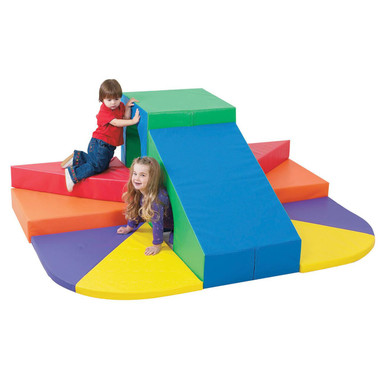
$1881.00
Get ready to conquer the mountains with the Tunnel Mountain Slide Soft Climber! Designed for little adventurers, this extraordinary wall climber offers an exciting and...… read more
When to Replace vs. Repair
1. Age-Related Deterioration Signs
Equipment age alone isn't necessarily a reason for replacement, but certain age-related deterioration signals shouldn't be ignored. Watch for fading colors that may indicate UV damage to plastics, which often correlates with decreasing structural strength. Similarly, increasing frequency of component failures typically indicates the equipment is reaching the end of its useful life.
Pay special attention to weight-bearing elements like platforms, connectors, and support structures. As materials age, their load-bearing capacity can diminish, potentially creating safety hazards. Regular professional inspections become increasingly important as equipment ages, as trained inspectors can identify deterioration patterns that might not be obvious to untrained observers.
2. Safety Hazards & Broken Components
Certain equipment conditions demand immediate replacement regardless of the equipment's age or overall condition. Cracked plastic components, especially on slides or climbing structures, create dangerous edges that can cause injuries. Similarly, torn nets or damaged safety railings compromise the equipment's ability to prevent falls and other accidents.
Missing fasteners, bolts, or connectors require immediate attention as they can lead to structural instability. While some components can be replaced individually, extensive damage often makes full replacement the more economical and safer choice. When evaluating whether to repair or replace, safety must always be the primary consideration—never attempt to operate equipment with known safety hazards.
3. Recalled Equipment Issues
Equipment recalls represent non-negotiable replacement triggers. Manufacturers issue recalls when they identify design flaws, material defects, or other issues that could compromise safety. Operating recalled equipment not only endangers users but also creates significant liability exposure for your business.
Stay informed about recalls by registering your equipment with manufacturers and regularly checking the Consumer Product Safety Commission (CPSC) website for updates. When a recall affects your equipment, immediately remove it from service and follow the manufacturer's instructions for obtaining repairs or replacements. Some recalls offer retrofitting options rather than full replacement, but these modifications must be implemented precisely as specified.
Smart Investment Decision Framework
1. Total Cost of Ownership Calculation
Making a truly informed decision requires looking beyond the initial purchase price to calculate the Total Cost of Ownership (TCO) over the equipment's expected lifespan. This calculation should include:
- Initial purchase price
- Installation costs
- Expected maintenance expenses
- Anticipated repair costs
- Estimated useful lifespan
- Insurance implications
- Potential revenue impact
New equipment typically commands a premium of 30-50% in initial cost but often delivers a longer useful life with lower maintenance requirements. By amortizing the purchase price over the equipment's expected lifespan, you can determine a more accurate annual cost. When calculated this way, premium equipment often proves more economical despite the higher upfront investment.
2. Business Type & Usage Considerations
Your specific business model and anticipated usage patterns should heavily influence your equipment decision. Facilities expecting high-volume usage, such as dedicated indoor playgrounds or family entertainment centers, typically benefit from investing in premium new equipment that can withstand intensive use.
Conversely, organizations with more occasional or seasonal usage patterns—such as churches, small daycares, or community centers—might find refurbished equipment sufficient for their needs. Consider not just current usage but your growth projections; undersized or lower-quality equipment might require premature replacement if your business expands rapidly.
3. Quality Assessment Checklist
When evaluating any indoor playground equipment, whether new or refurbished, apply this comprehensive quality assessment checklist:
- Safety certification: Verify compliance with ASTM, CPSC, and other relevant safety standards
- Structural integrity: Assess weight-bearing components, connection points, and overall stability
- Material quality: Examine durability of plastics, metals, and soft components
- Finish quality: Check for smooth edges, secure fasteners, and complete protective coverings
- Maintenance requirements: Review cleaning procedures, inspection needs, and general upkeep
- Warranty coverage: Understand what's covered, exclusions, and duration
- Replacement part availability: Confirm that parts will remain available throughout expected lifespan
For refurbished equipment, additionally verify the reconditioning process, request documentation of any replacements or repairs, and if possible, learn about the equipment's previous usage environment.
Whitney Plus Porthole Playhouse Cube
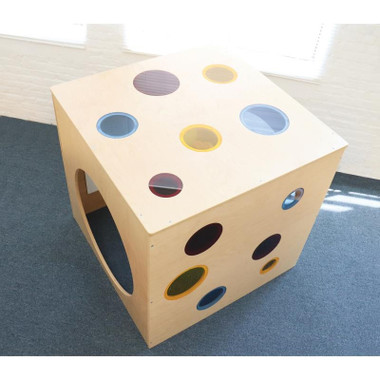
$2099.00
Transform any corner into a cozy reading nook with the Whitney Plus Porthole Playhouse Cube. This innovative playhouse cube features a porthole window design that sparks...… read more
Making the Right Choice for Your Business ROI
The decision between new and refurbished indoor playground equipment ultimately comes down to balancing short-term financial constraints against long-term operational goals. New equipment offers superior safety assurance, modern appeal, comprehensive warranties, and longer operational life—advantages that typically justify the higher initial investment for businesses focused on long-term success.
Refurbished equipment provides significant upfront savings and environmental benefits but comes with increased maintenance requirements, potential safety concerns, and shorter useful lifespan. For businesses with tight capital constraints or unique usage patterns, carefully selected and thoroughly inspected refurbished equipment can provide acceptable performance.
Regardless of which direction you choose, thorough research, professional inspection, and ongoing maintenance are essential for maximizing your return on investment. Remember that indoor play equipment isn't just an operational asset—it's a critical part of your customer experience and brand identity that directly influences parent satisfaction and repeat business.
For expert guidance on selecting the ideal indoor playground equipment for your specific business needs, Little People's Cove offers comprehensive consulting services that help you navigate this important investment decision.

